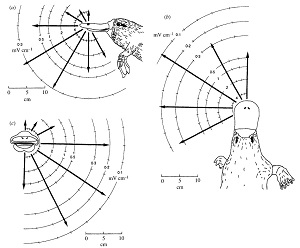

Manger & Pettigrew 1995
"The platypus can locate food by sensing the extraordinarily faint electric fields that their animal prey inadvertently produce [Gregory, E. 1991. Tuned-in , turned-on platypus. Natural History 99 (May):30-37]," writes John Alcock in Animal Behavior: An Evolutionary Approach. "Certain electric fish take this skill one step further by producing a weak electric field and then detecting disturbances to the field caused by a prey's intrusion into it [Lissman, H. W. 1963. Electric location by fishes. Scientific American 208 (Mar):50 59]." 1
National Geographic Wild presents a short documentary in World's Deadliest about the Platypus and the Australian animal's unique view into the electromagnetic world:
Underwater, this ungainly creature has a "sixth sense" that is hard to beat. Australia's platypus has the tail of a beaver, webbed feet,i and a bill like a duck. But this is no ordinary bill: it is a supersensory organ laden with thousands of cells responsive to the electric fields generated by all living things. So to hunt, the platypus closes its eyes, its ears and its nose, and lets its bill do the work. Called electrolocation, it is thought the waving back and forth motion…helps the platypus to locate exactly where the electric pulses are coming from.2
"Platypuses recognize electric potentials in a highly directional manner as opposed to electric fish that can only migrate linearly to the electric source," notes Meera Patel for Reed College:
The stripes found on the bill deliver messages through approximately 40,000 electroreceptors and 60,000 mechanoreceptors, creating bimodal input that can predict prey time-of-arrival by interpreting the time difference between the electric and mechanical waves (Pettigrew 1999). The stripes on the bill point to the direction that pray is located. Due to the large surface area of the bill, the receptors allow the platypus to create a local map with field lines that determine the location of prey. In fact, platypuses can respond to electric fields as low as 20mV per cm in a highly directional manner.3

Aristotle's five senses



Discovery's North America program presents a short documentary featuring a fox using the Earth's magnetic field "to catch a critter under three feet of snow":
He's homing in on something. But it takes immense concentration, and he needs complete quiet. His ears can pick up the faintest scamper from beneath the snow. But there's a catch. He almost always comes up empty handed unless he's facing north.… Scientists now think he's actually homing into the magnetic field of the planet using it to calculate and plot his trajectory, the kind of math missiles use to hit their targets.4
"There are at least nine senses and most researchers think there are more like twenty-one or so," notes Daven Hiskey for the Today I Found Out website:
The commonly held definition of a "sense" is "any system that consists of a group of sensory cell types that respond to a specific physical phenomenon and that corresponds to a particular group of regions within the brain where the signals are received and interpreted [and] are as follows":
- Sight: This technically is two senses given the two distinct types of receptors present, one for color (cones) and one for brightness (rods).
- Taste: This is sometimes argued to be five senses by itself due to the differing types of taste receptors (sweet, salty, sour, bitter, and umami), but generally is just referred to as one sense…based off of a chemical reaction.
- Touch: This has been found to be distinct from pressure, temperature, pain, and even itch sensors.
- Pressure: [Weight applied to the body by air, water, or some other pressing item.]
- Itch: Surprisingly, this is a distinct sensor system from other touch-related senses.
- Thermoception: Ability to sense heat and cold…is a completely different type of thermoceptor, in terms of the mechanism for detection, in the brain. These thermoceptors in the brain are used for monitoring internal body temperature.
- Sound: Detecting vibrations along some medium, such as air or water that is in contact with your ear drums.
- Smell: Yet another of the sensors that work off of a chemical reaction. This sense combines with taste to produce flavors.
- Proprioception: This sense gives you the ability to tell where your body parts are, relative to other body parts.…
- Tension Sensors: These are found in such places as your muscles and allow the brain the ability to monitor muscle tension.
- Nociception: In a word, pain. This was once thought to simply be the result of overloading other senses, such as "touch", but this has been found not to be the case and instead, it is its own unique sensory system. There are three distinct types of pain receptors: cutaneous (skin), somatic (bones and joints), and visceral (body organs).
- Equilibrioception: The sense that allows you to keep your balance and sense body movement in terms of acceleration and directional changes. This sense also allows for perceiving gravity.…
- Stretch Receptors: These are found in such places as the lungs, bladder, stomach, and the gastrointestinal tract. A type of stretch receptor, that senses dilation of blood vessels, is also often involved in headaches.
- Chemoreceptors: These trigger an area of the medulla in the brain that is involved in detecting blood born hormones and drugs. It also is involved in the vomiting reflex.
- Thirst: This system more or less allows your body to monitor its hydration level and so your body knows when it should tell you to drink.
- Hunger: This system allows your body to detect when you need to eat something.
- Magnetoception: This is the ability to detect magnetic fields, which is principally useful in providing a sense of direction when detecting the Earth's magnetic field. Unlike most birds, humans do not have a strong magnetoception, however, experiments have demonstrated that we do tend to have some sense of magnetic fields. The mechanism for this is not completely understood; it is theorized that this has something to do with deposits of ferric iron in our noses. This would make sense if that is correct as humans who are given magnetic implants have been shown to have a much stronger magnetoception than humans without.
- Time: This one is debated as no singular mechanism has been found that allows people to perceive time. However, experimental data has conclusively shown humans have a startling accurate sense of time, particularly when younger. The mechanism we use for this seems to be a distributed system involving the cerebral cortex, cerebellum, and basal ganglia. Long term time keeping seems to be monitored by the suprachiasmatic nuclei (responsible for the circadian rhythm). Short term time keeping is handled by other cell systems.5

"Magnetoception (or magnetoreception as it was first referred to in 1972 [M. LINDAUER & H. MARTIN in S. R. Galler et al. Animal Orientation & Navigation 559/1]) is a sense which allows an organism to detect a magnetic field to perceive direction, altitude or location," according to Wikipedia.6
"Several mammalian species spontaneously align their body axis with respect to the Earth's magnetic field (MF) lines in diverse behavioral contexts," report Vlastimil Hart et al:
Magnetic alignment, i.e., spontaneous alignment of the body with respect to the magnetic field lines, when other determinants (e.g. wind direction, sun position, curiosity) of the body position are negligible, has been demonstrated in several species of mammals in diverse behavioral contexts: in grazing and resting cattle, roe deer and red deer and hunting red foxes as well as in several other mammalian species (under preparation).…
Dogs preferred to excrete with the body being aligned along the North–South axis under calm MF conditions. This directional behavior was abolished under unstable MF. The best predictor of the behavioral switch was the rate of change in declination, i.e., polar orientation of the MF.7
"A study of Google Earth satellite images has revealed that herds of cattle tend to face in the north-south direction of Earth's magnetic lines," writes Jeremy Hsu, for the livescience.com website. "Google Earth is perfect for this kind of research, because the animals are undisturbed by the observer," said Sabine Begall, a zoologist at the University of Duisburg-Essen in Germany and coauthor on the study detailed in the journal Proceedings of the National Academy of Sciences.8
"A large variety of animals possess a magnetic sense," notes the Theoretical and Computational Biophysics Group:
Migratory birds use magnetic clues (in addition to light polarization, star signs, position of the sun) to find their way south in fall and north in spring. Salamanders, frogs, use the magnetic field for orientation when they have to find the direction of the nearest shore quickly, e.g., when they sense danger." 9
"Studies have shown that sea turtles use Earth's magnetic field to help guide them at sea," writes Laura Geggel, "but it was unclear whether magnetic features also help steer them toward the nesting sites chosen by their mothers":
For more than 50 years, scientists have been mystified by how sea turtles do this, said the study's lead researcher, J. Roger Brothers, a graduate student of biology at the University of North Carolina at Chapel Hill.
"Our results provide evidence that turtles imprint on the unique magnetic field of their natal beach as hatchlings, and then use this information to return as adults," Brothers said in a statement.…
"We reasoned that if turtles use the magnetic field to find their natal beaches, then naturally occurring changes in the Earth's field might influence where turtles nest," Brothers said.
A look at the data, from 1993 to 2011, confirmed this idea. At certain times in some places, Earth's magnetic field shifted so that magnetic signals from nearby beaches moved closer together. During these times, turtle nests densely covered these areas, they found.
Similarly, there were fewer turtle nests, and the nests were farther apart, in places where magnetic signatures diverged, just as the researchers predicted.10
"Many humans are able to unconsciously detect changes in Earth-strength magnetic fields, according to scientists at Caltech and the University of Tokyo."
The study, led by geoscientist Joseph Kirschvink (BS, MS '75) and neuroscientist Shin Shimojo at Caltech as well as neuroengineer Ayu Matani at the University of Tokyo, offers experimental evidence that human brain waves respond to controlled changes in Earth-strength magnetic fields. Kirschvink and Shimojo say this is the first concrete evidence of a new human sense: magnetoreception.11
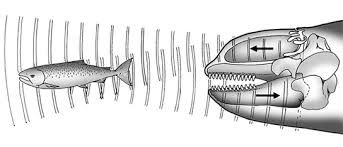
"Echolocation is the use of sound waves and echoes to determine where objects are in space," writes Arizona State University. "Bats use echolocation to navigate and find food in the dark." 12
"Daniel Kish is infamous for his abilities to see using sound despite being totally blind," writes perceivingacting at YouTube:
The notion of multimodal perception has been long promoted by some Gibsonian scientists and is understood via ecological psychology. That we can see - and hear - the shape of objects without using the eyes is understandable using the framework of invariants and invariant information - the same information across different senses: The senses are not the cause...the information is! (The senses are only the material cause, but the information is the formal cause, in Aristotelian terms).13

Neuromag-122TM at HUCH

The Neuromag-122TM neuro-magnetometer employs 122 detectors to collect the complete field distribution generated by brain activity. "With the development of multichannel magnetoencephalographs biomagnetic signals can be recorded over large areas at the same time," writes Knutsson and Gransberg. 1995. "It allows determination of the magnetic field outside the head." 14
"The technology works by measuring the extremely faint magnetic fields produced when nerve cells in the brain fire electrical signals to communicate with one another," explains the Dictionary of Scientific Literacy. "Biomagnetometers, which look like…beauty-parlor hair dryers, measure brain-generated magnetic fields that are one ten-millionth the strength of Earth's magnetic field." 15
"The biomagnetic signals originating from a[]…discharge is, however, mixed with biomagnetic signals generated by the background activity in the brain," note Knutsson et al.16
"A long auditory stimulus elicits a magnetic evoked response in the human brain, consisting of transient deflections followed by a sustained response," find Aittoneimi, Jarvinen, and Varpula, 1980. "The distributions of the magnetic fields indicate that the auditory evoked transient response at a latency of 100 ms as well as the auditory sustained response are generated at and around the primary auditory cortex." 17
"These fields exhibit features with a clear spatial symmetry which can be accounted for by assuming that their source consists of two vertically oriented neuronal complexes symmetrically located deep in the temporal lobes," find Tripp, Norgren and Teyler (1980). "This assignment, which is also consistent with the available electrical data, places the sources within the auditory cortex near the sylvian fissure." 18
Elberling, Bak, Kofoed, Lobech and Saermark (1981), study more effects of audio on the brain:
In…right-handed male adults,…[when] stimulating the right ear the averaged magnetic field from the left hemisphere is approx. twice as great as that from the right hemisphere, whereas stimulating the left ear no difference in magnitude is found.… The responses from contralateral stimulation are approx. 9 ms earlier than those from ipsilateral stimulation with no interhemispheric differences.19
When "the component of the magnetic field normal to the skull was measured; in some cases this component was oriented in the outward direction (group 1 and some group 2 subjects), in the other cases in the inward direction (group 2)," find Bak, Lebech and Saermark (1985).20
"By recording the magnetic field of the human brain while simultaneously presenting light to the eye and sound to the ear we have identified a brain region where auditory and visual signals converge," find Regan, He, and Regan (1995). "The location of this region is close to primary auditory cortex and far from primary visual cortex."21
"Exposure to static magnetic fields as used in NMR-equipment generates a new encephalomagnetic field in human brain," finds Von Klitzing (1991).22

"By measuring sleep parameters, the REM latency is shortened in the E-W position of sleepers compared with the N-S position," find Ruhenstroth-Bauer, Gunther, Hantschk, Klages, Kugler and Peters (1993). "There are statistically significant differences in the EEG of normal subjects, depending on whether the subjects sit facing the N-S or E-W direction. The difference is especially pronounced in the alpha-power." 23
Aldous Huxley notes in Brave New World Revisited:
In deep sleep the electroencephalograph records no alpha waves; in light sleep alpha waves make their appearance. In this respect light sleep is closer to the waking and hypnotic states (in both of which alpha waves are present) than it is to deep sleep.24
"The amount of data…[is] reduced by extracting broad band coherence values for…frequency bands; [including] delta (2-3.9 Hz), theta (4-7.9 Hz), alpha 1 (8-9.9 Hz), alpha 2 (10-12.9 Hz), and beta 1 (13-17.9 Hz)," note Harada, Shirasishi, Kato, and Soda (1996).25
"Brainwave-reading devices, which control computers hands-free, have become increasingly popular for entertainment, control of prosthetics for paralyzed individuals,ii and military application," writes Gregory Ferenstein for the TechCrunch website. "The latest commercial versions of brain-reading devices, often used by researchers and software developers, can cost as little as $300." 26
"At first, the headsets were more or less novelties, a fun new way to play video games, but as the technology improved, all kinds of industries – from medicine to education, security to government – are looking for ways to take advantage of brain-controlled interfaces," explains Adam_Clark_Estes on the MotherBoard website.27

"At the Usenix security conference in Seattle,…a group of researchers from the University of California at Berkeley, Oxford University and the University of Geneva presented a paper (PDF here) that hints at the darker side of a future where brain sensors are used to let thoughts manipulate computers as fluidly as a mouse," reports Forbes:

The researchers found they were able to extract hints directly from the electrical signals of the test subjects' brains that partially revealed private information like the location of their homes, faces they recognized and even their credit card PINs.
These devices have access to your raw EEG [electroencephalography, or electrical brain signal] data, and that contains certain neurological phenomena triggered by subconscious activities," says Ivan Martinovic, a member of the faculty in the department of computer science at Oxford. "So the central question we were asking with this is work was, is this is a privacy threat?" 28
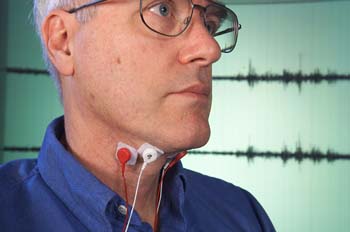
NASA Ames Research Center, Dominic Hart
"NASA scientists have begun to computerize human, silent reading using nerve signals in the throat that control speech," reports John Bluck with the Ames Research Center in California:
"What is analyzed is silent, or subauditory, speech, such as when a person silently reads or talks to himself," said Chuck Jorgensen, a scientist whose team is developing silent, subvocal speech recognition at NASA's Ames Research Center, Moffett Field, Calif. "Biological signals arise when reading or speaking to oneself with or without actual lip or facial movement," Jorgensen explained.
"A person using the subvocal system thinks of phrases and talks to himself so quietly, it cannot be heard, but the tongue and vocal chords do receive speech signals from the brain," Jorgensen said.29
"A team of Yale researchers, led by a then-undergraduate student, have made an astonishing step forward in brain science," reports the Geek.com website:
The (perhaps unsettling) breakthrough allows scientists to use a medical imaging machine and a well-trained algorithm to visually reconstruct faces seen by test subjects.…
Faces have historically been very difficult to see via the brain. Ever since brain scientists first found our visual processor (the occipital lobe, at the back of the head), they have tried to read and interpret its activity to reconstruct visual data. They reasoned that a detailed-enough model for how each "pixel" we see appears in the visual cortex would allow a one-to-one reconstruction — but that's only true some of the time. When viewing images like buildings or furniture, simple and inherently unemotional objects, we see mostly with our eyes. When we view a human face, on the other hand, we "see" it in both the visual and emotional brains, evaluate it on a visual and a personal level, and look at it through rotating lenses of trust, safety, sex, and more.…
This research used functional MRI scans (fMRI), which tracks neuro-excitation in real-time. The results are the first direct reading of visual information from outside of the visual cortex, and as can be seen in the figure above, it provided powerful results. Both the "occipital" and "non-occipital" constructions are inferior to the image using whole-brain information. By looking at areas like the ventral temporal cortex, they hope to get a more detailed view of perception than ever before.30


Visualization of the measurement concept. Two photons are separated into different paths, being each one in a superposition of many modes. The dimensionality of entanglement is determined performing 12 measurements, two projective measurements on each of the three components of the orbital angular momentum of each photon. — Quantum entanglement Credit: Krenn et al (2013)
"There are two primary quantum mechanics principles…found to be inescapable in the explanation of any type of phenomena or interaction: quantum entanglement and nonlocality," writes Amanda Flaker for the Chakra Center:
Quantum entanglement is the quantum principle through which atoms, cells, objects, and living organisms cannot be separated. Nothing is free of quantum entanglement.iii Things which are quantumly entangled should have, at some point in history, shared a link, common origin, or communication. Because atoms, cells, and physiological architecture can all be traced to the same root source, especially human DNA, quantum entanglement permeates our entire existence. This means every piece of existence affects one another in a profound, instantaneous way with every thought form, feeling, or action. The physical manifestations of these connections are what we usually notice, but the energetic interplay is far more significant.
Nonlocality is another principle of quantum mechanics, exposing space and time for its true illusory nature. Nonlocality works in tandem with quantum entanglement, connecting particles, creatures, and consciousness, irrespective of the third dimensional perspective of space-time limitations. This means a quantumly entangled particle from 2012 can simultaneously affect its counterpart in 1984.31
There's an expression in the English language: "tension so thick you can cut it with a knife." We as human animals feel psychic energy around us, but being dumbed down animals haven't been taught how to recognize it for what is. One billion tone deaf people, for example, could be tested to determine whether or not they can identify musical notes by their sound, and researchers would conclude that both relative and perfect pitch don't exist. Whereas testing a population of musicians will discover they possess both skills to varying degrees.
The senior psychologist at Coalinga Mental Hospital in California, Deirdre D' Orazio, Ph.D., interviewed in the documentary "A Place for Pedophiles" by Louis Theroux, responds to an argumentative sex offender with, "I'm feeling a lot of intensity: the energy in this corner of the room is palpable." 32

Powaqqatsi - po • waq • qa • tsi (from the Hopi language, powaq sorcerer + qatsi life) n., an entity, a way of life, that consumes the life forces of other beings in order to further its own life.

John-Roger warns us in his book Psychic Protection about psychic-sexual vampirism where people project energy in the form of a thought pattern while feasting on the resulting energy exchange. People "have the ability to move into a [person's] psychic space and extract [their] body energy" whether or not they mean to, he writes:
This form of vampirism may not always be directed on a sexual level, and it may not always be conscious on the part of the individual doing it. There are people who can, just by being near you, pull energy from you with their own magnetic force.33

Star Wars' Return of the Jedi provides a popular example of characters possessing psychic ability:
"Give yourself to the Dark Side, Luke," sneers Darth Vader. "Your friends have fallen into a trap. Their situation is hopeless."
"Never!" Luke Skywalker vows. "I will never turn." But the rage simmers in his soul as he watches the good guys being slaughtered in their battle with the storm troopers.
"Your thoughts betray you," says Vader.34
"Good psions are keenly aware of the corrupting effect telepathic powers can have if used unethically," notes Bruce R. Cordell in the Dungeons & Dragons' Psionics Handbook:
Evil psions, however, have no such compunctions against mental violence. If they corrupt the dreams or personalities of those who stand in their way, they take it as proof of their own mental superiority.…
Psionic powers arise from a regimen of strict mental discipline developed over months and years of self-scrutiny and mind-actualization. Those who overcome personal demons, neuroses, and other pitfalls of intense self-reflection learn to call upon an internal reservoir of power.
Psions depend on a continual study of their own minds to discover an ever-wider range of mental powers. They meditate on memories and the nature of memory itself, debate with their own fragment personalities, and delve into the dark recesses of their minds' convoluted corridors. "Know thyself" is not just a saying for a psion, but the road to power.35
"Everyone agrees that consciousness is a very special phenomenon, unique in several ways, but there is scant agreement on just how special it is, and whether or not an explanation of it can be accommodated within normal science," begins a review of John Searles' 1992 book The Rediscovery of the Mind posted at Tufts University:
In the course of making his positive case, Searle resolutely catalogues some of its rather costly implications, which I should think will seriously diminish the allure of an initial allegiance to his version of common sense.… Part of Searle's attempt to make a comfortable home for this unique doctrine is a thought experiment:…
Imagine that your brain starts to deteriorate in such a way that you are slowly going blind. Imagine that the desperate doctors, anxious to alleviate your condition, try any method to restore your vision. As a last resort, they try plugging silicon chips into your visual cortex. Imagine that to your amazement and theirs [not mine!--DCD], it turns out that the silicon chips restore your vision to its normal state. Now, imagine further that your brain, depressingly, continues to deteriorate and the doctors continue to implant more silicon chips. You can see where the thought experiment is going already: in the end, we imagine that your brain is entirely replaced by silicon chips. . . . In such a situation there would be various possibilities. One logical possibility, not to be excluded on any a priori grounds alone, is surely this: you continue to have all of the sorts of thoughts, experiences, memories, etc., that you had previously; the sequence of your mental life remains unaffected. (p.65-66)…
A "zombie" who perfectly fools the doctors (or Turing Testers) into thinking it is conscious must be a genuine possibility for Searle.36

SpooooookyCast: DIA Investigates the Paranormal
in an International Spy Museum interview with the Defense Intelligence Agency historian regarding telepathy, telekinesis, and remote viewing
"From the early 1950s on, United States intelligence explored psychic research, hoping to use extrasensory perception (ESP) for intelligence operations" note Marianne Szegedy-Maszak and Charles Fenyvesi for U.S. News & World Report:
After all, the Soviets were doing it. Nonetheless, officials were torn between worries that the Soviets—and later the Chinese—were ahead of the United States in the psychic arms race and the skepticism of many American officials about spending money in the field seen as dominated by kooks.… Far-fetched as it sounds, the remote viewers at Fort Meade were engaged in deadly serious work—an odd marriage of American intelligence-gathering and paranormal experimentation.…
[Richard Helms of the Central Intelligence Agency] argued that given the Soviet preoccupation with "cybernetics, telepathy, hypnosis, and related subjects . . . recent reported advances . . . may indicate more potential than we believed existed." 37
Footnotes
i The male platypus has "a sturdy erectile keratin spur on each hind leg…just above the webbed foot, which is connected via a venom duct to a venom (crural) gland lying under the dorsal thigh muscles." The male platypus aggressively injects venom into his opposition by "erecting the spur, grasping and squeezing the victim between his hind legs, and driving the spurs and venom into the victim's tissues" (Fenner, P.J., Williamson, J.A., Myers, D. 1992. Platypus envenomation—a painful learning experience. Medical Journal of Austrailia 157: 829-832).
When the platypus contracts his leg muscle, he also contracts the muscle wall of the crural gland, which forces 2-4 mL of venom through the hollow spur and into the victim (Fenner et al., 1992).
— Platypus Facts, Davidson College, at http://www.bio.davidson.edu/people/kabernd/
For most humans, ultraviolet light exists outside of the visible spectrum. But certain pigments can absorb it, drain off some of its energy, and re-emit what remains as a color that people can see. Many man-made things contain such pigments, including white T-shirts, Froot Loops and petroleum jelly.… So why would a platypus fluoresce? “We really don’t know,” Dr. [Erik] Olson said.
— Cara Giaimo, "Platypuses Glow Under Blacklight. We Have No Idea Why," 13 Nov 2020, at https://www.nytimes.com/2020/11/13/science/platypus-glow-ultraviolet.html (retrieved: 18 Mar 2022).
ii "Paralysis," a word derived from the Greek, refers to the loss of movement. It is typically caused by damage to upper motor neurons in the central nervous system (the brain and spinal cord) or lower motor neurons—peripheral nerves—that originate in the spinal cord and course through the limbs to the fingers and toes. Injuries may occur at any point in the chain of nerves originating in the brain and ending at the muscles.
— Jon Mukand, MD, PhD, The Man with the Bionic Brain: And Other Victories Over Paralysis (Chicago, IL: Chicago Review Press, 2012), p. x.
iii In a milestone for quantum computing, researchers at ETH Zurich have demonstrated quantum teleportation in a solid-state circuit. Even more, they've broken something of a quantum speed record – they estimate that their system could teleport 10,000 quantum bits per second. This teleportation occurred on a setup involving superconducting circuits in a configuration resembling a conventional computer chip.…
There are two big advantages to quantum teleportation – first, it's more information dense than current systems. A quantum bit (or "qubit") can hold more information than a classic bit. Second, it's more secure – the act of trying to eavesdrop on two entangled particles will affect the communication on the quantum level, letting the sender and receiver know that somebody's trying to intercept data.…
Entanglement is a very, very fragile process. Currently, the world record for quantum teleportation is a distance of about 88 miles. But if teleportation can occur in a solid state chip, the researchers note in a pre-publication version of their paper that the use of solid-state chips could lead to the development of "quantum repeaters." These quantum repeaters, like repeaters used in fiberoptic and radio transmissions you use every day when you make a cell phone call, could strengthen quantum teleportation signals over a network, enabling those signals to travel farther distances.
— Alex Knapp, "The First Quantum Teleportation In A Computer Chip," Forbes, 17 August 2013, at http://www.forbes.com/
References
1 John Alcock, Animal Behavior: An Evolutionary Approach, 5th ed. (Massachusetts: Sinauer Associates, Inc., 1993), p. 591.
2 "World's Deadliest : Platypus Hunts with "Sixth Sense"," NatGeoWild video at YouTube.com, http://www.youtube.com/watch?v=i7_l_FdIuLs (retrieved: 6 December 2013).
3 Meera Patel, "Platypus Electroreception," Reed College, Biology 342: Animal Behavior, Fall 2007, at http://www.reed.edu/
4 "Fox Dives Headfirst Into Snow | North America," Discovery video at YouTube.com, http://www.youtube.com/watch?v=D2SoGHFM18I (retrieved: April 2013).
5 David Hiskey, "Humans have a lot more than five senses," 16 July 2010, at http://www.todayifoundout.com/
6 Magnetoception, Wikipedia, at http://en.wikipedia.org/
7 Vlastimil Hart, Petra Nováková1, Erich Pascal Malkemper, Sabine Begall, Vladimír Hanzal, Miloš Ježek, Tomáš Kušta, Veronika Němcová, Jana Adámková, Kateřina Benediktová, Jaroslav Červený and Hynek Burda, "Dogs are sensitive to small variations of the Earth's magnetic field," Zoology 2013, 10:80, 27 December 2013, at http://www.frontiersinzoology.com/
8 Jeremy Hsu, "Cows Have Strange Sixth Sense," livescience.com, 25 August 2008, at http://www.livescience.com/
9 The Magnetic Sense of Animals, Theoretical and Computational Biophysics Group, University of Illinois at Urbana-Champaign, at http://www.ks.uiuc.edu/
10 Laura Geggel, "Sea Turtles Use Earth's Magnetic Field to Find Home," Live Science, 15 January 2015, at http://www.livescience.com/49468-turtles-migration-magnetic-field.html (retrieved: 14 February 2015).
11 "Evidence for a Human Geomagnetic Sense," CalTech, 18 March 2019, at https://www.caltech.edu/about/news/evidence-human-geomagnetic-sense (retrieved 3 September 2019).
12 perceivingacting, "Human echolocation - Daniel Kish, 'Batman'," YouTube.com, 5 July 2013, at http://www.youtube.com/
13 Amanda Flaker, "Quantum Empowerment 101," Chakra Center, 20 December 2012, at http://chakracenter.org/
14 E. Knutsson & L. Gransberg (Department of Clinical Neurophysiology, Karolinska Hospital, Stockholm, Sweden), Localization of epileptic foci with multichannel magnetoencephalography, MEG, Acta Neurochir Suppl (Wein), 1995, 64.
15 magnetoencephalography, Richard P. Brennan, Dictionary of Scientific Literacy, (New York, NY: John Wiley & Sons, Inc., 1992).
16 Knutsson and Gransberg, "Localization."
17 R. Hari, K. Aittoniemi, M. L. Jarvinen, T. Katila & T. Varpula, Auditory evoked transient and sustained magnetic fields of the human brain. Localization of neural generators, Experimental Brain Research, 1980, 40(2).
18 D. E. Farrell, J. H. Tripp, R. Norgren & R. J. Teyler, A study of the auditory evoked magnetic field of the human brain, Electroencephalogr Clin Neurophysiol, July 1980, 49(1-2).
19 C. Elberling, C. Bak, B. Kofoed, J. Lebech & K. Saermark, Auditory magnetic fields from the human cortex. Influence of stimulus intensity, Scan Audiology, 1981, 10(3).
20 CF. K. Bak, J. Lebech & K. Saermark, Dependence of the auditory evoked magnetic field (100 msec signal) of the human brain on the intensity of the stimulus, Electroencephalogr Clin Neurophysiol, Aug 1985, 61(2).
21 M. P. Regan, P. He, & D. Regan (Department of Psychology, York University, North York, Ontario, Canada. Martin/george.psych.yorku.ca), An audio-visual convergence area in the human brain, Experimental Brain Research, 1995, 106(3).
22 L. von Klitzing (Department of Clinical Research, Medical University Luebeck, Germany), A new encephalomagnetic effect in human brain generated by static magnetic fields, Brain Research, 1 Feb 1991, 540(1-2).
23 G. Ruhenstroth-Bauer, W. Gunther, I. Hantschk, U. Klages, J. Kugler & J. Peters (Max-Planck-Institut fur Biochemie, Martinsried), Influence of the earth's magnetic field on resting and activated EEG mapping in normal subjects, International Journal of Neuroscience, 1993, 73(3-4).
24 Aldous Huxley, Brave New World Revisited, 1958, at http://www.huxley.net/
25 H. Harada, K. Shiraishi, T. Kato, T. Soda, Coherence analysis of EEG changes during odour stimulation in humans, Journal of Laryngology and Otology, July 1996, 110(7).
26 Gregory Ferenstein, "Brain Hacking: Scientists Extract Personal Secrets With Commercial Hardware," TechCrunch, 27 August 2012, at http://techcrunch.com/
27 Adam_Clark_Estes, "The Downside to Brain Wave-Controlled Video Games: Hackers Can Read Your Thoughts," MotherBoard, 16 August 2012, at http://motherboard.vice.com/
28 "'Mind-Control' Gaming Devices Leak Brain Data That Help Researchers Guess Users' Secrets," Forbes, 16 August 2012, at http://www.forbes.com/
29 John Bluck, "NASA Develops System To Computerize Silent, 'Subvocal Speech'," NASA, 17 March 2004, at http://www.nasa.gov/
30 Graham Templeton, "Mind-reading breakthrough can recreate the faces you see in your brain," Geek.com, 26 March 2014, at http://www.geek.com/science/mind-reading-breakthrough-can-see-faces-in-your-brain-1589063/ (retrieved: 27 March 2014).
31 John-Roger, Psychic Protection, Revised (Los Angeles, California: Mandeville Press, 2004, 1997, 1976), pp. 141, 141-142.
32 "Louis Theroux - A Place for Pedophiles (FULL)," Magnus Gonzo video at YouTube.com, http://www.youtube.com/watch?v=RMlO8QE7pdE (retrieved: 27 July 2014).
33 John-Roger, Psychic Protection, Revised & Expanded Ed. (Los Angeles, CA: Mandeville Press, 1976, 1997, 2004), pp. 141-142.
34 Return of the Jedi, in Ross Anderson, A matter of opinion, 22 June 1997, The Seattle Times Pacific Magazine, p. 17.
35 Bruce R. Cordell, Psionics Handbook (Renton, WA: Wizards of the Coast, Inc.), at http://web.archive.org/
36 Review of John Searle, The Rediscovery of the Mind, MIT Press, 1992, in Journal of Philosophy, 60, (4), 193-205, Apr. 1993, at http://ase.tufts.edu/
37 Marianne Szegedy-Maszak and Charles Fenyvesi, "Enemies in the mind's eye: For more than 20 years, the CIA funded psychic experiments," U.S. News & World Report, 19 January 2003, at http://www.usnews.com/
See also
"Emotiv EPOC EEG Headset Hacked," kurzweilAI.net, 14 September 2010, at http://www.kurzweilai.net/
Ivan Martinovic, Doug Davies, Mario Frank, Daniele Perito, Tomas Ros, and Dawn Song, "On the Feasibility of Side-Channel Attacks with Brain-Computer Interfaces," at http://www.scribd.com/
Andra M. Smith and Claude Messier, "Voluntary out-of-body experience: an fMRI study," Frontiers in Human Neuroscience, 10 February 2014, at http://journal.frontiersin.org/
Kevin J. Crosby, "Escape From Tomorrow," SkewsMe.com, at https://skewsme.com/
Related merchandise
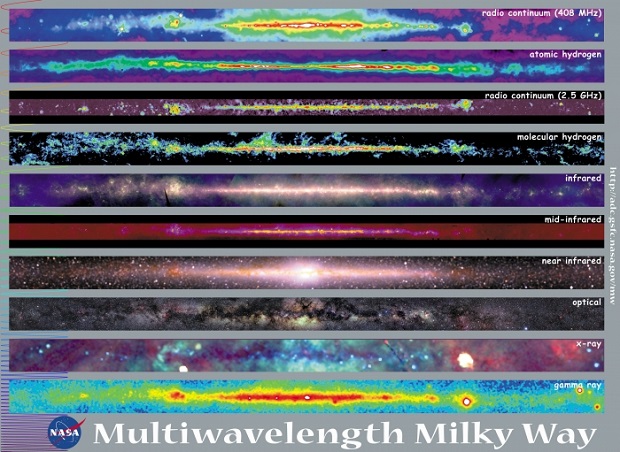






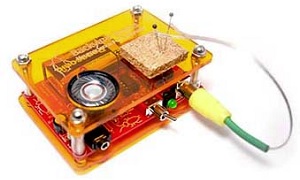







 The philosophy of Epicurus who subscribed to a hedonistic ethics that considered an imperturbable emotional calm the highest good, held intellectual pleasures superior to others, and advocated the renunciation of momentary in favor of more permanent pleasures.
The philosophy of Epicurus who subscribed to a hedonistic ethics that considered an imperturbable emotional calm the highest good, held intellectual pleasures superior to others, and advocated the renunciation of momentary in favor of more permanent pleasures.


